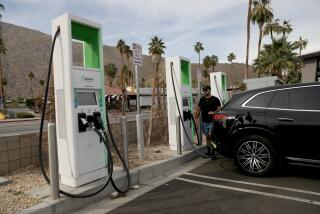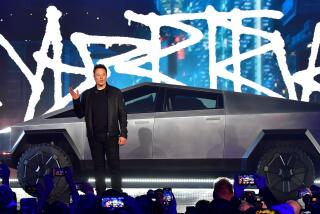Carmakers’ rebound is driving jobs in U.S.
Taxpayers bailed out much of the U.S. auto industry. Now the carmakers might be what saves the nation’s economy from falling back into recession.
After a massive restructuring and several high-profile bankruptcies, a leaner, more aggressive auto industry is making a comeback, hiring workers and ramping up manufacturing plants. From a trough two years ago, Ford Motor Co., General Motors Co., Chrysler Group and other auto companies have added almost 90,000 manufacturing jobs, a 14% increase, according to federal employment data.
Job growth in Michigan, which was devastated by the downturn, is even more robust. That’s why Michigan’s jobless rate stood at 10.9% in July, well below the 12% rate of California.
And it’s not just the Big Three American manufacturers that are thriving. Nissan, VW and other foreign-based firms are expanding in the United States, putting billions of dollars into building and refurbishing plants. Start-ups Tesla Motors in Palo Alto, Fisker Automotive in Anaheim and Coda Automotive in L.A. are hiring and spending hundreds of millions of dollars designing and launching electric and hybrid vehicles.
Dealers are having a banner year, making more money per sale than they have in years and hiring back some workers shed during the recession.
“I have been adding dozens of employees for sales and sales support,” said Mike Bowsher, who owns Chevrolet and Buick dealerships in Atlanta; Nashville, Tenn.; and Orlando, Fla. “The economy is crazy, but our retail business is still growing and getting better.”
The Commerce Department said Wednesday that orders for autos and auto parts jumped 11.5% in July, the most in eight years. That followed an earlier government report on industrial production that showed the auto industry was the strongest segment of the manufacturing economy last month.
This kind of expansion is important to the economy. Including factories, suppliers and dealers, the U.S. auto industry employs about 1.7 million workers and supports an additional 6.3 million private-sector jobs, according to the Center for Automotive Research in Ann Arbor, Mich. The center said those positions represent more than $500 billion in annual compensation and more than $70 billion in personal tax revenue.
“Autos are certainly picking up. As we get into next year, this all depends on the state of the consumer,” said Gary Schlossberg, senior economist Wells Capital Management.
Auto sales peaked at about 17 million in 2000 and held near that level until 2007 before crashing to just 10.4 million two years later. They were heading back into the 13-million range — helped by a wave of new models, low interest rates and improving consumer confidence — only to be upended by the Japanese earthquake in March.
Shutdowns at Japanese-owned factories in Japan and the United States created inventory shortages that led to sharply higher car prices, lower demand and hundreds of thousands of lost sales for dealers. But with those disruptions now in the rearview mirror, the industry is looking for sales to improve over the rest of the year.
The health of the U.S. economy is so dependent on autos that economists such as UCLA’s David Shulman are watching car sales to assess whether the nation’s recovery will accelerate or stall.
“If you see a 13-million-unit sales rate in the fourth quarter, that would help a lot,” said Shulman, senior economist at the UCLA Anderson Forecast. “It would be very hard to see how the U.S. would go into recession with cars selling at that rate.”
With their U.S. plants almost back to full production, Toyota Motor Corp. and Honda Motor Co. will be rebuilding their dealer inventories nationwide. They’re also launching incentives and in some cases lowering prices of new models to recapture lost sales. Toyota said this week that it was slashing the price of the Camry, America’s top-selling sedan, by hundreds or even thousands of dollars for some versions.
To compete, other manufacturers are expected to boost their incentives and discounts, which should help draw buyers back into showrooms.
Other factors are assisting as well.
The average age of passenger cars and light trucks in America has grown to almost 11 years as people delayed purchases during the downturn. Low-mileage used cars are in short supply.
And with the Federal Reserve signaling that it plans to keep interest rates low for several years, automakers are offering low-cost financing deals, making it easier for consumers to make a new-car payment.
This should all help to boost sales.
“The vehicles will be there. There will be a better incentive environment. Financing isn’t going to cost any more. Everything is in place; it is just a question of whether consumers will be too scared to act,” said Robert Schulz, an auto industry analyst with Standard & Poor’s.
Lacey Plache, economist at Edmunds.com, believes U.S. light vehicle sales will reach 12.9 million this year, and that means she expects the sales pace to pick up dramatically in the coming months.
“The demand for autos is still showing strength, and buying conditions will only improve through the fall as supply grows and prices come under pressure to fall,” Plache said.
Although most analysts are predicting growth, some said the auto industry and the overall economy still face significant hurdles.
Big gyrations in the stock market make consumers nervous, said Shulman, the UCLA economist. Volatility tends to have an outsized effect on high-end customers, and that could undermine the luxury car market, which typically has strong sales toward the end of the year.
A weak U.S. labor market also makes shoppers wary of big-ticket items.
But no matter how the next few months go, Shulman said, the automobile industry is healthy enough so that for once, “it won’t be what puts the economy into a recession.”
More to Read
Inside the business of entertainment
The Wide Shot brings you news, analysis and insights on everything from streaming wars to production — and what it all means for the future.
You may occasionally receive promotional content from the Los Angeles Times.











